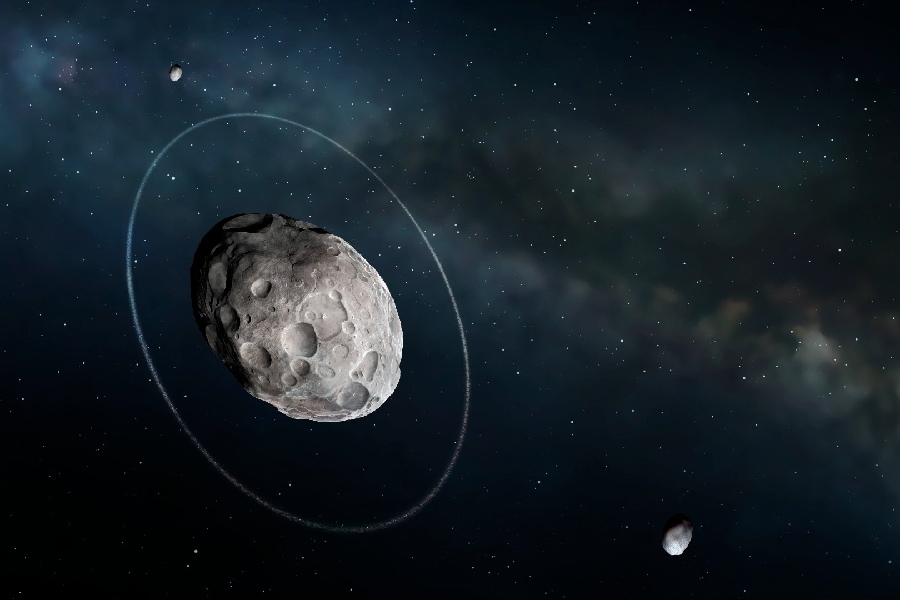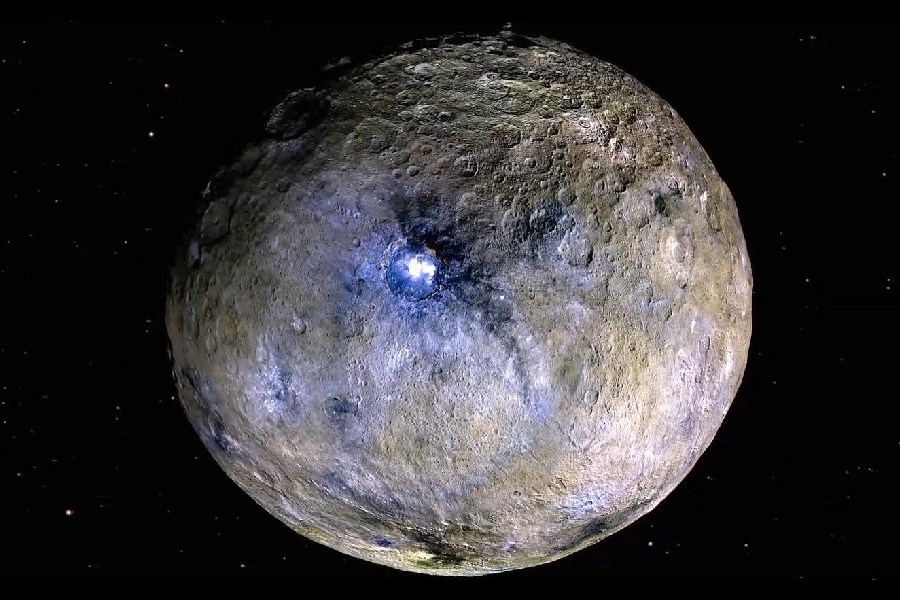Haumea, an intriguing dwarf planet residing in the Kuiper belt beyond Neptune, has captured the attention of astronomers with its unique characteristics. One of the most fascinating aspects of Haumea is its composition, which differs from most objects in its realm.
What comprises this unusual world named after the Hawaiian goddess of childbirth? As we dive into what is Haumea made of, you’ll unveil a story of collisions, ice, and potential hidden structures, offering a glimpse into the dynamic processes that shaped our solar system’s outer reaches.
This icy body spins unusually rapidly and boasts an odd shape resembling a football due to its extreme elongation. These characteristics prompt questions regarding Haumea’s internal structure and evolution over billions of years in the Kuiper belt’s frozen reaches.
We will explore scientific findings that reveal the densities as well as the chemistry and physics of its materials. We aim to decode the insights Haumea holds deep beneath its surface. Read on as we shed light on the intricate riddle of its formation.
What Is Haumea Made Of?
What is Haumea made of? Haumea, like other dwarf planets such as Pluto, is primarily composed of rock and ice. Its surface is believed to be covered by a layer of crystalline water ice. The unusual shape of Haumea indicates it may have experienced a significant collision in the past, shaping its composition and features.
Studying Haumea’s makeup provides insights into the formation and evolution of objects in the outer regions of the solar system. This enriches our understanding of planetary bodies beyond the more well-known planets.

Composition of the mantle
Haumea’s mantle has a complex mixture. The mixture contains various ices. These ices are water ice, ammonia hydrate, and methane clathrates. It also contains rocks such as silicates and metals. Studies of Haumea’s density and surface spectroscopy reveal details about these likely substances within its interior layers.
The interaction between the different components influences the mantle’s structure and properties over geological timescales. As an example, the clathrates may depressurize and release gasses that could drive resurfacing. Cryovolcanic processes may exchange material between layers.
The exact ratios of the materials remain uncertain without direct samples. However, assumptions can be made. They are based on comparisons to comets and other Kuiper belt objects. Haumea formed under similar conditions billions of years ago. This formation occurred in the early life of the Solar System.
Water ice
Water ice makes up a high percentage of Haumea’s icy outer mantle. The bright white surface seen today is composed almost completely of pure water ice. This surface ice is thought to have formed later on from the internal differentiation of Haumea, whereby denser components sank while lighter ice rose to the top.
This water ice mantle greatly affects Haumea’s high surface albedo and other properties. The dynamic evolution and fluid nature of water ice are influenced by the temperature of the environment, which fluctuates more wildly at great distances far from the sun.
Different isotopes of water may reveal information about Haumea’s formation location relative to the solar nebula. The purity and age of the surface water ice give insights into Haumea’s resurfacing.
This resurfacing may have been caused by collisions. Or it may have been caused by possible cryovolcanic flows. In the far future, this water could be a useful resource if ever utilized by human exploration in the outer solar system.
Ammonia hydrate and methane clathrates
Included within the water ice mantle are the icier compounds ammonia hydrate and methane clathrates. These hydrates and clathrates provide information about the cold environment where Haumea first accreted. As inclusions within the water ice, they lower the overall density of Haumea’s icy outer layers.
The ammonia and methane influence the rheology and viscosity of the ice. They also depressurize and outgas over time which could drive cryovolcanism on Haumea via these antifreezes.
Understanding the ratios of these ices assists in modeling of the phase equilibrium within dwarf planet interiors and allows more accurate determinations of the bulk composition.

Organic material
Observations have identified a dark reddish organic-rich area on Haumea’s surface. These organics are likely primeval leftovers from the original formation location of Haumea, which are still preserved today and mixed in with the water ice.
Spectroscopic studies have revealed these carbon-rich compounds. Relationships between Haumea’s surface organics and those detected on many icy bodies can be drawn, opening clues to their delivery and redistribution.
Outgassing could concentrate organics and result in the observed patchy surface terrain. Biotic chemistry concepts might even apply to understanding complex organics in the deep icy mantle and interior shifts.
Silicates and metals
Interior modeling of Haumea’s densities suggests a significant rock component buried deep within its mantle. These are likely dense silicates similar to olivine and pyroxene. The silicates and metal alloys comprise the leftover core from Haumea’s ancient internal differentiation.
This points to a small, dense former core underneath today’s thick, icy layers. The style of silicate differentiation ties into models of Haumea’s formation and collisional history.
If we compare silicate ratios and mineral phases to other Kuiper belt objects, it probes conditions. Specifically, it probes the ancient thermochemical conditions where accretion happened. This accretion occurred billions of years ago. The silicates influence the structural properties of Haumea’s deep interior through factors like viscosity and heat flow as well.
Composition of the core
Haumea likely has an inner rocky core made of silicates and metals. Its exact interior makeup is unknown. Models differ in core size and composition. Some evidence exists for a subsurface water ocean between the icy mantle and inner core. The core may resemble other Kuiper belt objects (KBOs).
The core’s high density contrasts greatly with the low-density icy mantle. This sharp gradient probably aided the separation and layering very early in Haumea’s history when internal heating was much higher. The core’s silicates may exhibit exotic mineral phases, unlike terrestrial rocks.
Subsurface ocean
An internal liquid water ocean is considered possible beneath Haumea’s icy mantle. Ammonia and other types of antifreeze could allow a liquid layer. Tidal studies reveal intriguing interior flexing consistent with a decoupling between surface and core. A global ocean would have implications for astrobiology within Haumea.
If confirmed, oceans could exist mainly between the silicate core and thick high-pressure ice layers overlaying it. Liquid water would depend on antifreeze content, internal heating, insulating ice caps, and ambient pressure conditions within Haumea.
Conclusion
So, we have illuminated some of the inner mysteries of distant Haumea and covered the origins of its elongated football shape and rapid spin.
By piecing together insights from density calculations, surface spectroscopy, and comparisons to fellow Kuiper belt objects, we have shined a light on what Haumea is made of. It is the mixture of frozen volatiles and minerals that comprise this remote mini-world.
We hope you have a renewed appreciation for the marvels to be found even at the Solar System’s outer limits. There, tiny planetesimals like Haumea can unlock secrets of planetary beginnings. As we continue studying its composition and dynamism, we further unveil the answers to what is Haumea made of, as well as our cosmic origins in the Sun’s family of worlds.
